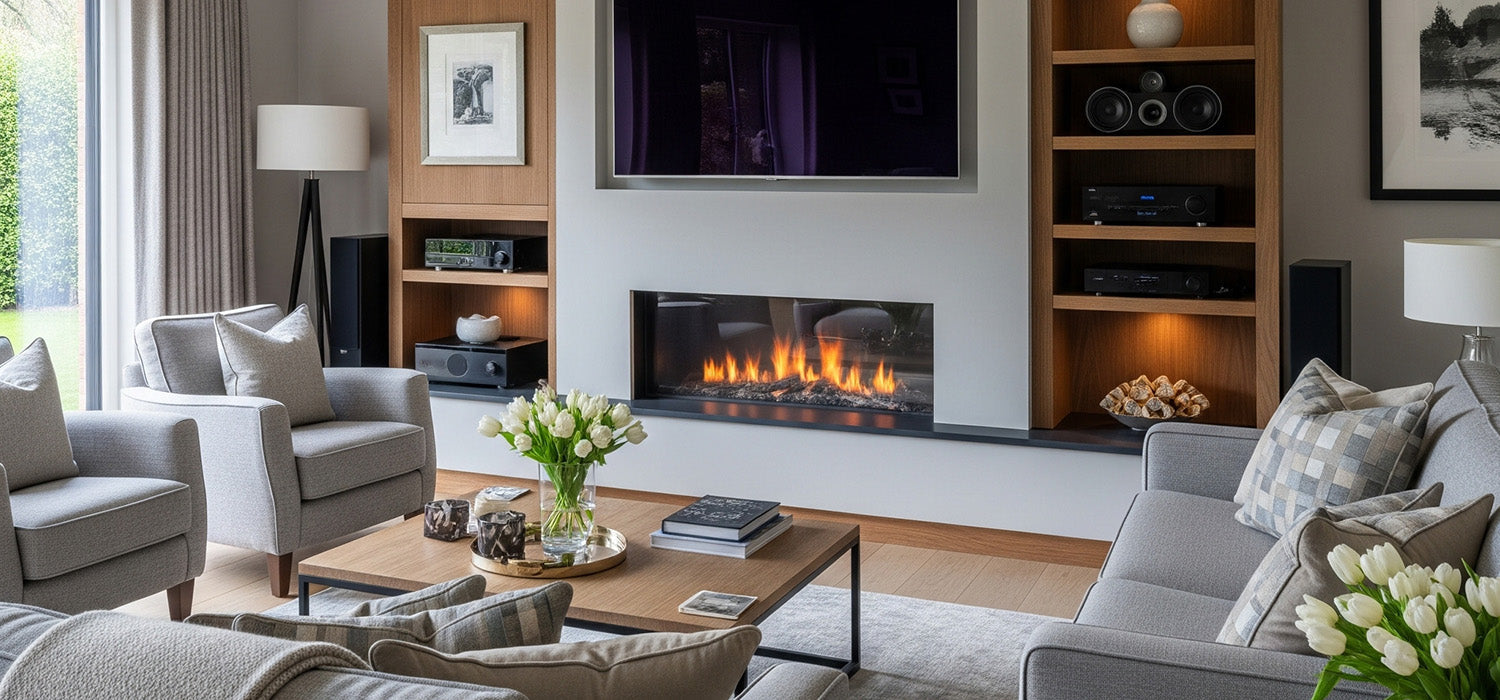
Can You Build a Media Wall Without Plastering?
Can you build a media wall without plastering? Absolutely — and without the mess, dust, or waiting weeks for plaster to dry. Whether you're dreaming of a sleek setup or a cosy media wall fire, there are stylish, screw-and-click solutions that save time, money, and stress. More homeowners are ditching the trowel in favour of modern materials that can be installed quickly with minimal hassle. Ready to DIY smarter? Let’s explore your options.
Why Consider Building Without Plastering?
Building a media wall used to mean long days of plastering, sanding, and drying — not to mention the disruption to your home life.
But things have changed.
Now, whether you’re in a new-build flat or updating a Victorian terrace, you can craft a stunning centrepiece in your living room without ever mixing plaster.
It’s quicker, cleaner, and doesn’t require specialist skills.
Take Lucy from Manchester, for example. She transformed her plain lounge into a cosy Netflix nook in just one weekend — all using MDF panels and a bit of patience.
Material Choices for a Plaster-Free Media Wall
The best part of skipping plaster is the freedom it gives you. From textured wood to ultra-modern finishes, you can create a space that reflects your style — no drying time required.
Painted MDF
MDF is a firm favourite. It’s easy to cut, affordable, and gives a smooth surface once painted.
Just remember to seal the edges with primer — it soaks up paint like a sponge otherwise. Two coats of satin or eggshell paint later, and you’ve got a wall that looks polished and professional.
Plywood Panels
Want something warmer? Go for plywood. It brings a natural woodgrain effect, perfect for Scandi-inspired designs.
Birch plywood gives you a high-end look, while softwood ply is easier on the wallet. A quick sand and a coat of matt varnish can do wonders.
Wood Veneer or Slatted Panels
For something really special, try veneered boards or ready-made slatted panels. These are great if you’re going for a premium feel — think boutique hotel vibes.
Slatted oak panels with built-in LED strips? Now you’re talking.
Decorative Cladding
If you want to make a statement, stone-effect cladding or 3D wall panels can be installed directly over your frame. No plaster, just adhesive and creativity.
They’re especially popular behind wall-mounted TVs or electric fires, adding texture without effort.
Preparation and Building Tips (Without Plaster)
A beautiful finish starts with solid prep — and a level frame is everything.
Mark out the area on your wall, measure twice, and use timber battens or a metal stud frame to build your structure. Use a spirit level at every step. You’ll thank yourself later.
Panels can be screwed or glued into place. Use grip adhesive for decorative boards, or fix MDF directly to your timber frame with countersunk screws.
Once installed, use wood filler to cover any screw holes. Sand everything smooth before painting or sealing.
And here’s a tip from the trade: always dry-fit your panels first. You don’t want to realise something’s off after it’s glued down.
Smart Finish Options That Beat Plaster
Modern media walls are all about character. So why not use this as an excuse to try something new?
-
Reclaimed wood: great for rustic charm — even better if it tells a story.
-
Textured slats: ideal for hiding speakers or cable runs.
-
Painted shiplap: clean and coastal, perfect for light-filled living rooms.
-
Acoustic fabric panels: functional and cosy — ideal if you're building a media wall fire setup.
And don’t forget lighting. Recessed LED strips behind floating shelves or panelling give that extra glow, especially for movie nights.
Cost and Time: The Real Perks
Plastering a wall typically takes up to three weeks from start to finish — especially if you need professional help.
By contrast, you could have your DIY media wall finished in a couple of days. A full MDF setup (including materials and paint) might cost under £300, depending on size.
Modular panels are slightly pricier but save loads on labour. And since you won’t need to sand or re-paint every few years, it’s a smart long-term choice too.
Think of it as investing in a weekend project that delivers year-round impact.
Common Pitfalls to Avoid
Even without plaster, things can go wrong. Here’s how to steer clear of the most common snags.
-
Wavy walls: Fix by packing behind battens or using adjustable brackets.
-
Visible joins: Use trims or caulk where boards meet.
-
Overheating: Leave gaps behind the TV for ventilation — especially if you're adding a media wall fire.
-
Cable chaos: Run wires through trunking or use brush plates for a tidy finish.
If you’re unsure where power or HDMI sockets go, sketch it all out first. Or better yet, lay everything out on the floor before fixing anything.
A Real-Life Look: Jack’s Weekend Project
Jack, a homeowner from Sheffield, turned his small lounge into a home cinema using nothing but MDF, a mitre saw, and sheer determination.
He framed out a recess for his TV, added slatted panels on either side, and installed LED lighting from a local DIY store. No plaster, no contractors, and no regrets.
“Honestly,” he says, “the hardest part was choosing the paint colour.”
Final Thoughts
Building a media wall without plastering isn’t just possible — it’s preferable for many.
You get to skip the dust, ditch the drying time, and still enjoy a designer finish. Whether you’re going for sleek and modern or warm and rustic, there’s a material and method to suit your style.
With just a few tools, the right panels, and a bit of patience, you can create a standout feature that transforms your space — and you’ll never need to mix a bucket of plaster.
So, roll up your sleeves and get building. Your dream media wall is only a weekend away.
Other content we think you'll love
- Can I Build a Media Wall Myself? A DIY Guide for UK Homes
- How to Build a Stylish Media Wall with TV & Fireplace
- Can You Build a Media Wall Over a Radiator? A Stylish Guide
- Can You Build a Media Wall on Carpet? Tips for a Stable Setup
- Can You Build a Media Wall Around a Fireplace? A Cosy & Stylish Upgrade
- How to Build a Media Wall on a Chimney Breast (UK Guide)
- Can You Build a Media Wall in a Council House? A Practical Guide
- The Ultimate Guide to Buying a Pre-Made Media Wall in the UK
- How to Attach Plasterboard to a Media Wall: A Step-by-Step Guide
- How Deep Should Your Media Wall Be? A Guide to Perfect Fit & Function
- Are Media Wall Fires Safe? What Every UK Homeowner Should Know
- How is a Media Wall Built? A Step-by-Step DIY Guide
- MDF vs Plasterboard for Media Walls: Which Should You Choose?
- What Are the Disadvantages of Media Walls? A Cautionary Guide
- What is a Media Wall? The Ultimate Living Room Glow-Up

